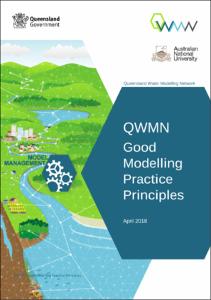| dc.contributor.author | Jakeman, A. J. | |
| dc.contributor.author | El Sawah, S. | |
| dc.contributor.author | Cuddy, S. | |
| dc.contributor.author | Robson, B. | |
| dc.contributor.author | McIntyre, N. | |
| dc.contributor.author | Cook, F. | |
| dc.date.accessioned | 2022-04-04T13:45:12Z | |
| dc.date.available | 2022-04-04T13:45:12Z | |
| dc.date.issued | 2018 | |
| dc.identifier.citation | Jakeman, A.J., El Sawah, S., Cuddy, S., Robson,B., McIntyre, N. and Cook, F. (2018) QWMN Good Modelling Practice Principles. Queensland, Australia, State of Queensland Department of Environment and Science, 44pp. DOI: http://dx.doi.org/10.25607/OBP-1738 | en_US |
| dc.identifier.uri | https://repository.oceanbestpractices.org/handle/11329/1911 | |
| dc.identifier.uri | http://dx.doi.org/10.25607/OBP-1738 | |
| dc.description.abstract | Best practice modelling reduces model uncertainties and quantitatively and qualitatively
documents any uncertainties and assumptions for user transparency. Conversely, poor
modelling practices contribute to uncertainties and increase user distrust in the value of
modelling.
This paper synthesises existing knowledge and experience on good water modelling
practices and principles. Specifically, it provides guidance for new and existing water model
development efforts, and informs end users and decision makers about what distinguishes
good modelling practices from poor ones. The paper covers the following:
1. An introduction to water models and their role in decision making;
2. An overview of water modelling practices, and the role of best practice modelling
in improving model quality and results;
3. A characterisation of best practice modelling in relation to each of the phases and
steps in the modelling process, including checklists of things that modelling
practice should explicitly address.
This paper’s scope covers the use of water resource models to investigate impacts on the
environmental system in question, such as a paddock, catchment, or estuary. It includes
model use under both status quo conditions and in response to management actions,
climate variations or other uncontrollable forces. It also includes model uses to adaptively
manage a system, such as through additional monitoring and informative studies.
The following best practice water modelling recommendations warrant specific attention by
water model developers and users:
- Specify the objectives, clients and stakeholders for the modelling exercise clearly.
- Document the nature of the data used to build and test the model.
- Justify the selection of model type and calibration method.
- Undertake extensive model testing and report on results, model limitations and assumptions.
- List and characterise information and data sources and try to rank the criticality of
uncertainties arising in the entire modelling process by means including expert
elicitation, stakeholder engagement, sensitivity and other more quantitative
uncertainty analyses.
- Carefully consider appropriate model complexity, taking into account uncertainty,
data support and system behaviours. This is likely to include effective simplification
with good documentation of the assumptions made and their implications.
- Inform the users of model results about the dangers of being provided only a single
number upon which to base decisions. Also address their needs by providing
uncertainty information in a format that fits within their workflows.
- Factor in the appropriate costs of a holistic uncertainty assessment in project
budgeting. It will be worth it in the long-term.
- Place due emphasis on communicating uncertainty. Visualisation of indicators of
concern is one aspect that can be used. The design of such visualisations should pay
special attention to possible interpretation biases and techniques to manage them.
- Pay explicit attention to the way model results and uncertainty are communicated in
written reports and publications.
- Ensure model visualisations employ user-centred designs early in the modelling
process, and leverage different visualisation tools to engage different audiences (e.g.
researchers, policy makers, stakeholders).
- Embrace the use of automated methodologies that can both support transparent
experimental workflows and allow for systematic understanding of the impacts of the
various relationships and factors that influence the model’s results.
- Pay careful attention to the collected data, including ensuring that they measure the
appropriate variables, at the correct locations and with the required frequency.
- All modelling practices should address the checklists of questions specified in this
paper for each phase of the modelling process.
- Help instil good modelling practice within the community by adopting these
recommendations and sharing and collaborating on best practice cases in the major
water modelling domains | en_US |
| dc.description.sponsorship | State of Queensland Department of Environment and Science | en_US |
| dc.language.iso | en | en_US |
| dc.publisher | State of Queensland Department of Environment and Science | en_US |
| dc.rights | Attribution 3.0 Australia | * |
| dc.rights.uri | http://creativecommons.org/licenses/by/3.0/au/deed.en | * |
| dc.subject.other | Uncertainty quantification | en_US |
| dc.subject.other | Ocean modelling | en_US |
| dc.subject.other | Water modelling | |
| dc.subject.other | Queensland Water Modelling Network | |
| dc.title | QWMN Good Modelling Practice Principles. | en_US |
| dc.type | Report | en_US |
| dc.description.status | Published | en_US |
| dc.format.pages | 44pp. | en_US |
| dc.description.refereed | Refereed | en_US |
| dc.publisher.place | Queensland, Australia | en_US |
| dc.subject.parameterDiscipline | Physical oceanography | en_US |
| dc.subject.dmProcesses | Data analysis | en_US |
| dc.description.currentstatus | Current | en_US |
| dc.description.sdg | 14.a | en_US |
| dc.description.eov | N/A | en_US |
| dc.description.adoption | Multi-organisational | en_US |
| dc.description.methodologyType | Reports with methodological relevance | en_US |
| obps.resourceurl.publisher | https://science.des.qld.gov.au/__data/assets/pdf_file/0011/81110/qwmn-good-modelling-practice-principles.pdf | |
 Repository of community practices in Ocean Research, Applications and Data/Information Management
Repository of community practices in Ocean Research, Applications and Data/Information Management

